Handout - 1 3G standards overview
《如何做经营分析pt》PPT模板

Y4…70 Y570
…
Level 5 MT
7727 7748
0855 0862
Netbook
S
Excellent handout template
Special lecture notes
收集相关信息:关于会计核算
• 会计的目的 • “三大”报表:上市报表,税务报表,管理报表 • 管理报表维度和数据平台 • 核算设计
xxx
xx
•Warranty cost review & update
•New biz review •Opportunity discussion
xxx
xx
• Product ID strategy
xxx
xx
Excellent handout template
几点体会
Special lecture notes
Evaluation/Incentive
▪ Evaluation System ▪ Accountability ▪ Incentive Structure
Excellent handout template
经营分析的框架:屋顶图
Special lecture notes
List Price
Up-front margin to BP
1999年加入联想,曾负责预算管理,资金管理,收购兼并以及合资公司管理,租赁业务,上市业绩发布等 工作。现任联想集团副总裁,产品集团CFO。 2004年作为财务小组负责人参与收购IBM PC业务的谈判工作,并在新公司成立后,外派美国三年负责新 公司整合,全球预算管理,全球定价工作
2007年加入联想IDEA产品集团任CFO,从无到有搭建IDEA集团财务体系,流程,业务模式。成功的组建 了一支能打硬仗的消费财务团队,并在她的带领下,在全新独特的业务模式和税务模式下成功的实现了消 费业务香港离岸模式。支持消费产品在美国,法国,波兰,土耳其,印度,拉美等100多个国家的发布。 2009年获得联想最高荣誉“联想奖”。2010年完成IPG和TPG财务团队整合,跨文化有效实现和国际团队 的无缝沟通。
SAEAMSE高温测定法中英文对照版
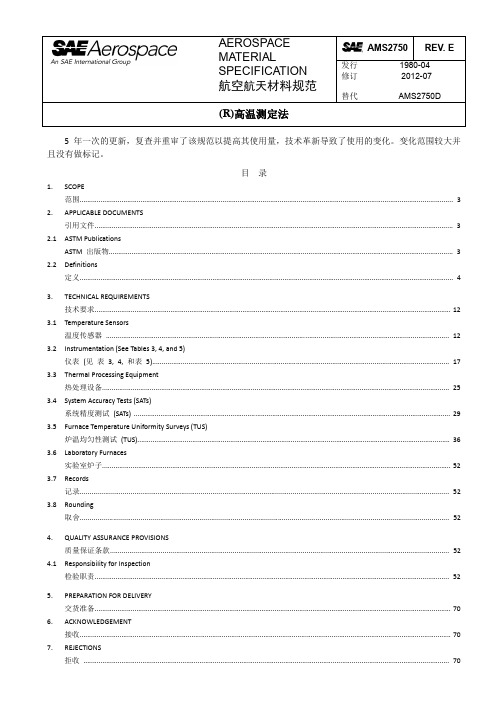
FIGURE 3 INSTRUMENTATION TYPE REQUIREMENTS
图3
仪表类型要求........................................................................................................................................................................... 27
Байду номын сангаасAE
AMS 2750E 中文译版
Page: 2 / 73
8. NOTES
注释.................................................................................................................................................................................................... 70
3.7 Records 记录............................................................................................................................................................................................. 52
AEROSPACE MATERIAL SPECIFICATION 航空航天材料规范
(R)高温测定法
AMS2750 REV. E
ASMEⅢND

ASMEⅢNDASME 锅炉及压力容器规范国际性规范 III 核设施部件建造规则美国国家标准第 1 册 ND 分卷 3 级部件 2004 版 2004 年 7 月 1 日ASME 锅炉及压力容器委员会核动力分委员会编著上海发电设备成套设计研究院翻译上海核工程研究设计院上海科学技术文献出版社 2004 版核电有关的 ASME 锅炉及压力容器规范翻译出版委员会名单主任:常务副主任:副主任:委员:(以姓名比画为序) 2 出版说明美国机械工程师学会(ASME)颁布的《锅炉及压力容器规范》(简称《ASME 规范》或《规 )范》,是目前世界上公认的范围最为广泛、内容最为详尽的一部关于锅炉及压力容器规范。
该系列的《规范》在一些国家已得到广泛应用,有些国家的规范、标准也来源于 ASME 规范。
规范自 1914 年正式问世以来至今已有九十余年历史,在近三十年中,规范保持每三年修订一次,颁布新的版本。
至今已扩展至 11 卷 28 册的系列型规范。
其中第 III 卷《核设施部件建造规则》已扩展到 3 册 12 部分卷,它与第 II 卷《材料》、第 V 卷《无损检测》、第 VIII 卷《压力容器建造规则》、第 IX 卷《焊接和钎焊评定》、第 XI 卷《核电厂部件在役检查规则》等综合在一起形成了核电厂部件的材料、设计、制造、焊接、检测、运行等方面一套完整的标准体系。
随着我国核电工程以及相应的核电工业和科技的纵深发展,为更好地消化吸收国外先进的规范、标准体系,积极推进我国自主核电部件设计、制造事业的发展,并为建立我国自主核电部件标准体系创造良好条件。
翻译出版 ASME 核电方面规范有了新得需要。
在 2006 年 2 月 1 日上海发电设备成套设计研究院与美国机械工程师学会(ASME)签订了许可协议,ASME 授权翻译出版核电有关的 2004 版 BPV-III、BPV-XI、OM、AG-1、QME 和NQA 等规范、标准和导则。
PDA TR03翻译
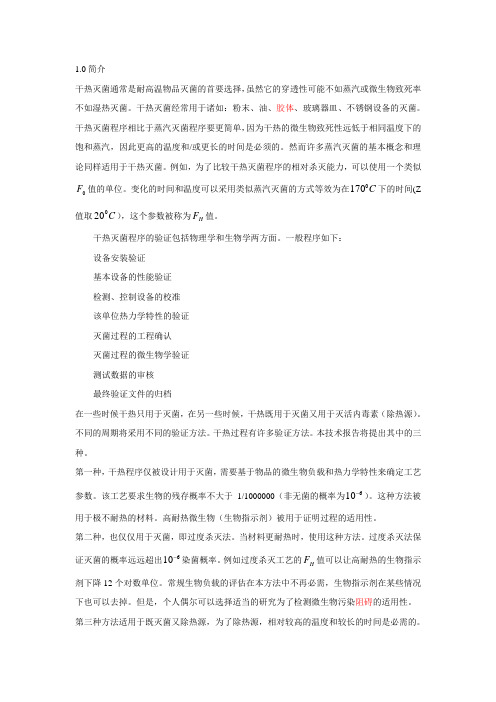
1.0简介干热灭菌通常是耐高温物品灭菌的首要选择,虽然它的穿透性可能不如蒸汽或微生物致死率不如湿热灭菌。
干热灭菌经常用于诸如:粉末、油、胶体、玻璃器皿、不锈钢设备的灭菌。
干热灭菌程序相比于蒸汽灭菌程序要更简单,因为干热的微生物致死性远低于相同温度下的饱和蒸汽,因此更高的温度和/或更长的时间是必须的。
然而许多蒸汽灭菌的基本概念和理论同样适用于干热灭菌。
例如,为了比较干热灭菌程序的相对杀灭能力,可以使用一个类似0F 值的单位。
变化的时间和温度可以采用类似蒸汽灭菌的方式等效为在C 0170下的时间(Z 值取C 020),这个参数被称为H F 值。
干热灭菌程序的验证包括物理学和生物学两方面。
一般程序如下:设备安装验证基本设备的性能验证检测、控制设备的校准该单位热力学特性的验证灭菌过程的工程确认灭菌过程的微生物学验证测试数据的审核最终验证文件的归档在一些时候干热只用于灭菌,在另一些时候,干热既用于灭菌又用于灭活内毒素(除热源)。
不同的周期将采用不同的验证方法。
干热过程有许多验证方法。
本技术报告将提出其中的三种。
第一种,干热程序仅被设计用于灭菌,需要基于物品的微生物负载和热力学特性来确定工艺参数。
该工艺要求生物的残存概率不大于1/1000000(非无菌的概率为610-)。
这种方法被用于极不耐热的材料。
高耐热微生物(生物指示剂)被用于证明过程的适用性。
第二种,也仅仅用于灭菌,即过度杀灭法。
当材料更耐热时,使用这种方法。
过度杀灭法保证灭菌的概率远远超出610-染菌概率。
例如过度杀灭工艺的H F 值可以让高耐热的生物指示剂下降12个对数单位。
常规生物负载的评估在本方法中不再必需,生物指示剂在某些情况下也可以去掉。
但是,个人偶尔可以选择适当的研究为了检测微生物污染阻碍的适用性。
第三种方法适用于既灭菌又除热源,为了除热源,相对较高的温度和较长的时间是必需的。
Thus, the microbial lethality delivered by these cycles provides a margin of safety far in excess of10 probability of nonsterility。
美国113标准

1美国联邦法规21CFR第113部分热力杀菌-密封容器包装的低酸性食品索引节号113.3 定义113.5 现用优良制造实施(良好生产实践) 113.10 人员113.40 装备和操作规程 (a)静止高压蒸汽杀菌锅 (b)静止加压水杀菌锅(c) 连续性回转式高压蒸汽杀菌锅 (d)分批回转式高压蒸汽杀菌锅 (e)分批回转式回压水杀菌锅 (f) 静水压高压蒸汽杀菌设备(g)无菌装罐(热处理和包装)加工系统 (h)火焰杀菌设备(i) 和aw有联系的杀菌 (j) 其他系统 113.60 容器 (a)封口 (b)冷却(c) 代号打印 (d)杀菌后处置113.81 产品预处理113.83 热力杀菌工艺规程制订 113.87 热力杀菌车间操作 113.89 杀菌偏差 113.100 记录113部分:热力杀菌、密封容器包装的低酸性食品亚部 A 总则节号113.3 定义113.5 现用优良制造实施(良好生产实践) 113.10 人员亚部 B (保留) 亚部 C 设备节号113.40 设备和操作亚部 D 组成分、食品容器、封口和加工过程中用料的控制节号113.60 容器亚部 E 生产和杀菌管理节号113.81 产品预处理113.83 热力杀菌工艺规程的制订 113.87 热力杀菌车间操作 113.89 杀菌偏差亚部 F 记录和报告节号113.100 记录亚部A—总则§113.3 定义本部适用的下列定义:(a)“无菌装罐(热处理和包装)(Aseptic processing and packaging)”意指无菌环境中将商业杀菌冷却食品装入预杀菌容器并用预杀菌罐盖封口的过程。
(b)“泄气口(Bleeders)”意指用以排除杀菌锅和蒸汽室内随蒸汽进入的空气并促进杀菌锅和蒸汽室内蒸汽循环的孔口。
泄气口还可用以排除冷凝水。
(c)“升温时间(Come-up-time)”意指密闭高压杀菌锅引入蒸汽和高压杀菌锅到达预定杀菌温度之间所需要的时间。
有色金属矿山水文地质勘探规范
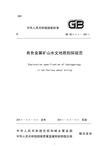
UDC中华人民共和国国家标准P GB 50×××– 201×___________________________________________________有色金属矿山水文地质勘探规范Exploration specification of hydrogeologyin non-ferrous metal mining201×–××–×× 发布 201×–××–×× 实施___________________________________________________中华人民共和国住房和城乡建设部联合发布中华人民共和国国家质量监督检验检疫总局中华人民共和国国家标准有色金属矿山水文地质勘探规范 Exploration specification of hydrogeology in non-ferrous metal miningGB 50×××– 201×主编部门:中国有色金属工业协会批准部门:中华人民共和国住房和城乡建设部 施行日期:201×年××月××日中国建筑工业出版社201×北京中华人民共和国住房和城乡建设部公 告第×××号 ————————————————————————前 言根据住房和城乡建设部《关于印发<2011年工程建设标准规范制订、修订计划>的通知》(建标[2011] 17号)的要求,规范编制组经广泛调查研究,认真总结实践经验,参考有关国际标准和国外先进标准,并在广泛征求意见的基础上,制定本规范。
本规范共分9章和13个附录。
主要内容包括:总则,术语,基本规定,矿区水文地质勘探,矿区工程地质勘探,水资源与环境地质评价,矿山防治水水文地质勘探,其他专项水文地质勘查,报告编制提交要求。
servo one操作手册
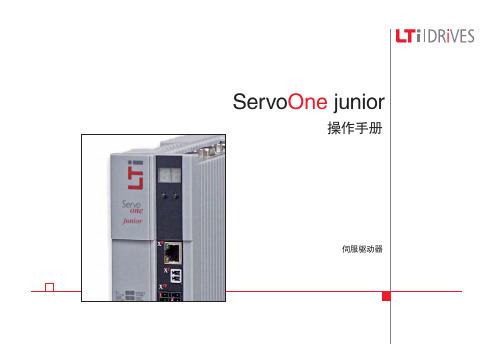
操作手册
伺服驱动器 2.0 A to 8 A
ServoOne junior 操作手册
ServoOne junior 高性能驱动器
ServoOne junior采用模块化设计,以确保在机械加工过程中发挥其最佳性能集。 无论高速现场总线与中央多轴设备控制器的通讯,还是与伺服驱动器中的分布式可编程 智能运动控制程序通讯,ServoOne junior均能应用自如。
预期用途................................................................................................................. 10 责任........................................................................................................................ 10
公告机构: 识别号: EC型式试验
TüV Rheinland Industrie Service GmbH Am Grauen Stein, 51105 Köln 0035 Certificate No.: 01/205/5036/10
授权编写本技术文件的人员: Matthias Wagner, Gewerbestrasse 5-9, 35633 Lahnau (Germany) CE标志年份: 2010
3.12 编码器接口 ............................................................................................................. 26 3.12.1 旋变(Resolver)接口 X6 ............................................................................. 28 3.12.2 高分辨率编码器接口 X7 .............................................................................. 28 3.13 电机连接................................................................................................................. 29 3.13.1 LSH/LST电机的连接 ................................................................................... 30 3.13.2 接通电机电缆............................................................................................... 31 3.14 制动电阻(RB)....................................................................................................... 31
UL1310 测试项目解析
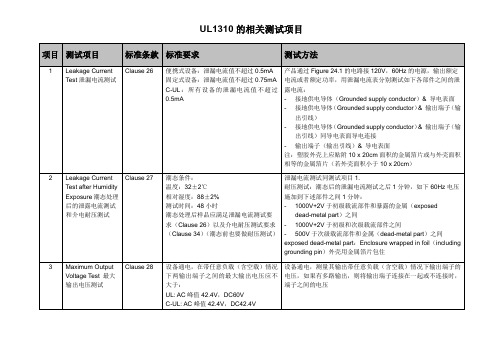
测试项目
标准条款
标准要求
测试方法
1
Leakage Current Test泄漏电流测试
Clause 26
便携式设备:泄漏电流值不超过0.5mA
固定式设备:泄漏电流值不超过0.75mA
C-UL:所有设备的泄漏电流值不超过0.5mA
产品通过Figure 24.1的电路接120V,60Hz的电源,输出额定电流或者额定功率,用泄漏电流表分别测试如下各部件之间的泄露电流:
Clause 31
非固有保护产品所提供的保护装置在通以标准中Table 31.1里规定的测试电流时,应在标准中Table 31.1里规定的时间内开路。上述测试完成后要做耐压测试。
这个测试后,产品须满足如下结果:
-没有火光或熔化的金属从产品里面出来,纱布没有烧焦、着火和起燃。
-产品没有产生开孔,以使电压超过42.4Vpeak的危险带电部件暴露出来
如果有多人输出,应考虑输出之间连接或不连接时的最大输入功率。
5
Output Current and Power Test输出电流和功率测试
Clause 30
在此测试中,器具下垫两层白色薄纸,上面用两层纱布遮住。
最大输出电流和最大输出功率不应超过标准中的值(Table 30.1和Table 30.2)。
如果产品有多路输出,,怎把输出相互连接,重复上述的测试。
C-UL:测试电路须连接一个class A GFCI,输出要接到地(Ground)。
这个测试后,产品须满足如下结果:
-没有火光或熔化的金属从产品里面出来,纱布没有烧焦、着火和起燃。
-产品没有产生开孔,以使电压超过42.4Vpeak的危险带电部件暴露出来
-(C-UL)Class A GFCI没有开路
雅思口语第一课
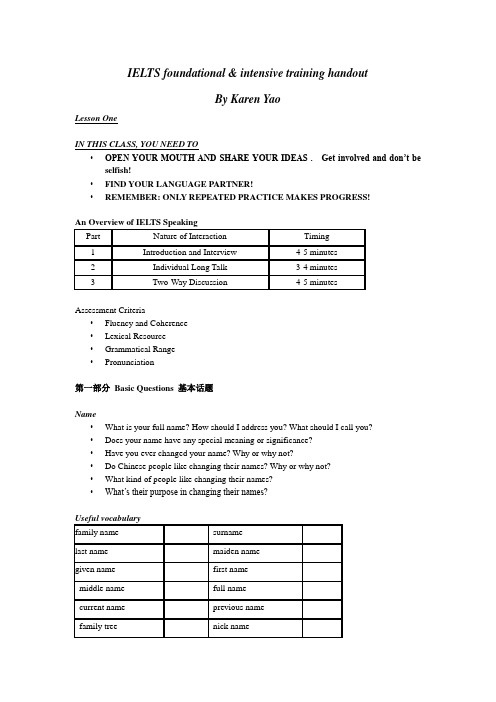
IELTS foundational & intensive training handoutBy Karen YaoLesson OneIN THIS CLASS, YOU NEED TO•OPEN YOUR MOUTH AND SHARE YOUR IDEAS . Get involved and don’t be selfish!•FIND YOUR LANGUAGE PARTNER!•REMEMBER: ONLY REPEATED PRACTICE MAKES PROGRESS!Assessment Criteria•Fluency and Coherence•Lexical Resource•Grammatical Range•Pronunciation第一部分Basic Questions 基本话题Name•What is your full name? How should I address you? What should I call you?•Does your name have any special meaning or significance?•Have you ever changed your name? Why or why not?•Do Chinese people like changing their names? Why or why not?•What kind of people like changing their names?•What’s their purpose in changing their names?Studies• 1. Are you working or studying?• 2. Tell me something about the school or university you attend.• 3. Tell me something about your primary school.• 4. What is your major?• 5. Do you like your major and why?• 6. What course/subjects do you study?•7. What is your favorite course/subject?Useful vocabulary•education•MA•MBA•bachelor•university•institute•private school •qualification •compulsory schooling •specialized course •compulsory/required course/subject •kindergarten•primary/elementary school •high school•senior high school •conventional school•credit•distance education•drop-out•study abroad•freshman•junior•undergraduate•university entrance examination •BA•MSc•MPA•master•degree•college•polytechnic•diploma•pre-school•basic course•optional course•major•certificate•secondary school•junior high school •tertiary education •correspondence education •curriculum•institutions of higher education •further one’s study overall development •absenteeism •sophomore•senior。
ASTM Standards Online - Plus Edition 使用者手冊说明书

ASTM Standards Online – Plus EditionUser Guide目錄組織介紹 (01)涵蓋領域 (02)標準類型 (02)紅線標準 (02)標準編號 (03)標準分類 (03)連線方式 (05)聯絡管道 (05)操作模式 (06)組織介紹ASTM國際標準組織(ASTM International)成立於1898年,是世界上最早、最大的非盈利性標準制定組織,其主要任務是制訂材料、產品、系統和服務的特性和性能標準及促進有關知識的發展。
ASTM前身是國際試驗材料協會(International Association for T esting Materials, IATM),主要研究解決鋼鐵和其他材料的試驗方法問題。
1898年6月16日,70名IATM會員在美國費城集會,成立了國際試驗材料協會美國分會。
1902年在國際試驗材料協會分會第五屆年會上,宣告美國分會正式獨立,取名為美國試驗材料學會(American Society for T esting Materials)。
該學會的工作不僅僅是研究和制定材料規範和試驗方法標準,還包括各種材料、產品、系統、服務專案的特點和性能標準,以及試驗方法、程式等標準。
因此,1961年,該組織又將其名稱改為美國試驗與材料協會(American Society for T esting and Materials, ASTM),一直延用至2008更名為ASTM國際標準組織(ASTM International)。
ASTM國際標準組織現有32000多名會員,分別來自於100多個國家的生產者、用戶、最終消費者、政府和學術代表。
在一項標準編制過程中,對該編制感興趣的每個會員和任何熱心的團體都有權充分發表意見,委員會對提出的意見都給予研究和處理,以吸收各方面的正確意見和建議。
標準草案經歷了一個詳盡無遺的投票過程,在每一投票階段,謹慎地注意少數人的意見,經過技術分委員會和技術委員會投票表決,在採納大多數會員共同意見並由大多數會員投票贊成,標準才獲批准,作為正式標準出版。
Handout12
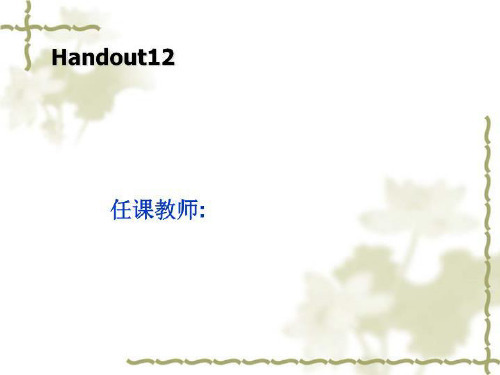
s
V2s
I
(/cm)
桂林电子科技大学
现代半导体器件物理与工艺
测量学和缺陷检查 11
方块电阻(不透明薄层)方块电阻间接用于测量淀积在绝缘衬底的不透 明导电膜的厚度,例如金属、硅化物或半导体膜。只要薄层大且探针的 间距小,方块电阻(Rs)就可由下式得到:
Rs
4.53V I
(/
)
桂林电子科技大学
桂林电子科技大学
现代半导体器件物理与工艺
测量学和缺陷检查 18
掺杂浓度
在硅的一些区域(如pn结、外延层、掺杂多晶硅)中杂质原子的分布情 况直接影响到半导体器件的性能(见图)。现在的工艺使用杂质浓度界 于1010个原子每平方厘米到大约1018个原子每平方厘米之间。有几种技术 用于测量硅中杂质浓度或硅原子的剂量。
X射线薄膜厚度 X射线束聚焦在表面,通过很少用到的X射线荧光技术 (XRF)来测量膜厚。当X射线射到薄膜时,吸收的辐射激活薄膜中的电 子。当受激电阻落入低的能态,发射出X射线光子(简称荧光),光子的 能量代表薄膜原子的特性。通过测量这些X射线光子,就可以确定膜厚 (见图)。
桂林电子科技大学
现代半导体器件物理与工艺
成品率广泛用于半导体生产,用它来反映工艺流程是否正常。高的成品 率标准着工艺生产的产品合格并按设想进行。低的成品率说明在产品设 计和制造中有质量问题,必须进行改进予以解决。
桂林电子科技大学
现代半导体器件物理与工艺
测量学和缺陷检查 7
质量测量
在整个硅片生产工艺中有许多质量测量,说明了集成电路工艺测量学的 广泛性。通过电学测量,半导体质量测量定义了硅片制造的规范要求, 以确保满足器件的性能和可靠性。表中展示了主要的质量测量,包括每 一步进行测量的工艺部分。半导体制造商为使其产品在工艺的每一步都 符合精确的要求,制定了特殊的质量测量规范。
handout-3-casting
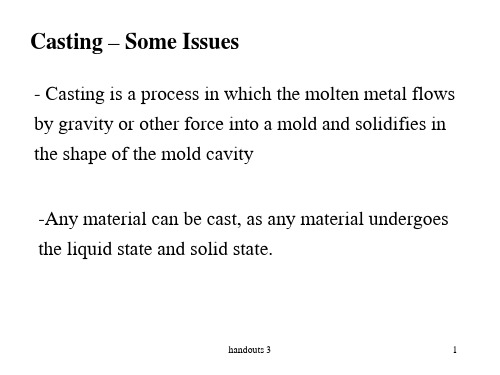
handouts 3
4
Casting – Some Issues (2) heat of fusion to convert
the solid to the liquid 3.1 Heating Period Thermal Analysis
H V{Cs (Tm T ) H f Cl (Tp Tm )}
handouts 3
7
Cm is a function of - mold material
- thermal properties of the cast metal
- pouring temperature relative to the melting point of the metal.
handouts 3
8
Implication of Chvorinov’s Rule:
A casting with a higher volume-to-surface area ratio will cool and solidify more slowly than one with a lower ratio.
handouts 3
22
Casting – Some Design Issues
Two sections intersects: two problems:
Stress concentration
shrinkage
Heat energy required for (1) heat for raising the temperature to the melting point, (2) heat of fusion to convert the solid to the liquid, and (3) heat for raising the molten metal to the metal at the desired temperature ready to pour it into a cavity.
Topic Overview -Student Handout

/2015/01/pf-feb-2015-economic-globalization.html#Resolved: On balance, economic globalization benefits worldwide poverty reduction.Introduction This is potentially a very interesting topic. Given that ECONOMIC globalization refers to a kind of ECONOMIC interdependency between nations, we could explode the grounds of debate and discuss a myriad of contentions including the impact of globalization on security,the impact on health, the impact on the environment, the impact on the balance of power and world politics, the impact on the role or multinational corporations on world politics, and of course, the impact on worldwide poverty. The RESOLUTION founders have chosen to limit the grounds to the impact on worldwide poverty. So, while Pro will be laying out a case which very pragmatically describes how globalization is the single most important mechanism in the history of the universe to solve poverty, and reap all of its enormous inherent advantages; Con may very well explode the debate with every single negative impact every witnessed as a result of globalization, so long as it somehow links to poverty. After all, what good is reducing poverty if it means the world is more polluted, there are even less fossil fuels to go around, new and exotic diseases are more easily spread, and so on, ad-infinitum. Conversely, the Pro can take a similar route and link a plethora of potential benefits to poverty. After all, the poor are helped when the chances or war are reduced, or when infrastructure is created, or when services are upgraded and personal wealth increases. Whew...just how much work will the well-prepared debaters have to do to turn all these potential impacts?/2015/01/pf-feb-2015-economic-globalization.html#Defining the ResolutionWe need to look at the intent and meaning of the resolution in order to extract the topical grounds.On balanceThis is common debate vernacular which in essence, instructs the debaters and judges to assign relative WEIGHTS to benefits and harms and then determine which way the balance beam tilts. By stating, on balance, there is an implicit acknowledgement that both sides have merit. In other words, we admit there are harms and there are benefitsbut when we objectively examine these claims on the basis of some kind of comparative framework, we will find that one side's impacts outweigh the other side's impacts. We just need to be aware of what it is we need to weigh. More on this in a future post.ECONOMIC globalizationWhen a thing is globalized it is extended throughout the world. Now in terms ofeconomies, internally, each nation has its own economy which we can loosely define as a system for producing and consuming goods and services. When the system of producing and consuming extends across the border of other countries and the two economies become interdependent, the process of globalization increases./2015/01/pf-feb-2015-economic-globalization.html#Shangquan 2000:Economic globalization refers to the increasing interdependence of world economies as a result of the growing scale of cross-border trade of commodities and services, flow of international capital and wide and rapid spread of technologies. It reflects the CONTINUING expansion and mutual integration of market frontiers, and is an irreversible trend for the economic development in the whole world at the turn of themillennium. The rapid growing significance of information in all types of productive activities and marketization are the two major driving forces for economic globalization. In other words, the fast globalization of the world’s economies in recent years is largely based on the rapid development of science and technologies, has resulted from the environment in which market economic system has been fast spreading throughout the world, and has developed on the basis of increasing cross-border division of labor that has been penetrating down to the level of production chains within enterprises of different countries. [page 1]There are a lot prerequisites to allowing economies to interconnect. There needs to be peace, trade agreements, political agreements, agreements on the value of goods and services, communication between the parties, an infrastructure for delivering good and services. And, as stated by the following author one cannot underestimate the impact of multinational corporations./2015/01/pf-feb-2015-economic-globalization.html#Prakash 1999:There is much confusion on what exactly globalization is, how to measure it, who caused it, and how it may impact human existence. I propose the following definition of economic globalization: it is a set of processes leading to cross-border integration of factor, intermediate products, and final products MARKETS along with an increasing salience of multinational corporations in economic activity. Three aspects of this definition are noteworthy. First, globalization is best viewed as a set of processes and not as an end state. Second, cross-border economic integration now spans products andcommodities that are at various stages of the value-addition processes. Third,multinational corporations are the main agents of economic integration. In fact, I would submit that the main difference between globalization now and the previous phases of economic integration is the increasing role of multinational corporations.[page 1]I suppose it is also important to note, both sides must have something to gain which outweighs any inherent difficulties or harms. Therefore, if we acknowledgethat ECONOMIC globalization is taking place, we acknowledge that the parties involved presumably have something to gain from the exchange./2015/01/pf-feb-2015-economic-globalization.html#benefitsRemember, in the context of this resolution, benefits is a verb and not a noun. So if we can define the noun, benefits, as good or helpful outcomes, we could describe the verb, benefits, as actions which result in good or helpful outcomes. Now that may not seem significant and on many levels it is not so significant except to say that if there is an action, there must be an agent to take the action and in this case it is economic globalization which takes the actions which result in good outcomes. Based on these semantics, Con can potentially constrain Pro to only allow direct links between good outcomes and economic globalization. In other words, Pro cannot claim that security, or political stability, or other kinds of "agents" which produce good outcomes should be evaluated in the debate. However, I do think it will be a very, very difficult tactic for Con to undertake.worldwideOne can easily understand that worldwide means extending throughout the world. I think it would be silly to take this term too literally and make the claim there are many places, like, uh mm, North Korea or Somalia which have not benefited so therefore we should vote Con. For me it is not unreasonable to limit the discussion to the countries throughout the world which are actively engaged in legitimate economic exchange with other other countries, rather than isolated economies cut-off by economic sanctions or those which are perhaps considered, failing states. On the other hand, I think Con can make very compelling arguments that in some cases, these isolated or failed states are in some ways the result of economic globalization./2015/01/pf-feb-2015-economic-globalization.html#poverty reductionPoverty is one of those things that is hard to define but you pretty much know it when you see it. Technically, we can say poverty is a state of being extremely poor or living below some socially accepted standard of living. Therefore, poverty is a very difficult standard to globalize except in the most general of terms. So, if we can't sufficiently define what poverty is, how do we know if it is reduced? well, let's start with the idea that reduced means fewer people are in the condition we describe as "in poverty" and for the determination of what is the socially accepted standard of living we must consider these standards on a case by case basis relative to the local conditions of a single nation or state or city or community. Generally speaking we can say if one can not adequately provide sustenance for oneself or family, or one may die unnecessarily or prematurely due to a lack of provisions widely available to other members of the society, then one is living in poverty./2015/01/pf-feb-2015-economic-globalization.html#Barder 2009:There is a healthy debate about how to achieve poverty reduction in developingcountries, but not enough discussion of what we mean by “poverty reduction.” “Poverty reduction” is often used as a short -hand for promoting ECONOMIC growth that will permanently lift as many people as possible over a poverty line. But there are manydifferent objectives that are consistent with “poverty reduction,” and we have to make choices between them. There are trade-offs between tackling current and future poverty, between helping as many poor people as possible and focusing on those in chronic poverty, and between measures that tackle the causes of poverty and those which deal with the symptoms.[Page 1]The Barder quotation is interesting because we can understand how economicglobalization in the form of economic development (investing in infrastructure, resource extraction, land development, etc.) impacts developing countries. However this debate does not require us to focus solely on developing countries. It is fair to ask, what has been the impact of globalization on those living in poverty in fully developed nations? Is there something inherent in economic globalization which further entrenches and constrains the poor people living in developed nations?/2015/01/pf-feb-2015-economic-globalization.html#Another source describes poverty as being incapable of achieving certain minimal standards regardless of personal income.Kakwani 2006:According to the capability approach, an individual is defined as poor if he or she lacks basic capabilities. What ought these basic capabilities to be? An answer to this question requires value judgments, which must reflect appropriately assessed social priorities. While, there is no universal agreement on what these basic capabilities are, it may still be possible to agree on some basic capabilities. For example, if a person is not able to be wellnourished, adequately clothed and sheltered, and not able to avoid preventable morbidity, then he or she can be classified as deprived of basic capabilities. Those capabilities that relate to health, education, shelter, clothing, nutrition and CLEAN WATER can reasonably be regarded as capabilities that we can agree are basic.[page 1]What it MeansFor most of you, this debate will focus on a fairly narrow examination of benefits and harms arising from economic globalization so I would expect you to be filling your files with evidence supporting either point of view. The fascinating and wide-open potential debate will look at the many advantages and disadvantages of economic globalization and their impacts on the world's poor. In these debates, time frame will play a role because while in the short-term, economic globalization may appear to be the cure forpoverty, in the long term it could lead to a major downturn in fortunes. Conversely, while some may argue the near-term benefits of globalization are marginal at best, the long-term future is bright for those most affected by substandard living conditions. No matter how deeply you want to take it, have fun. I think this is going to be a memorable topic which you will think about often in the coming years.Sources:Barder, O.; What is poverty reduction?; Working Paper 179; Center for Global Development; April 2009; accessed 1/5/2014./files/1421599_file_Barder_Poverty_Reduction.pdfKakwani, N.; what is poverty?; Internation Poverty Center, United Nations Development Programme; Sep 2006; No. 22; accessed 1/5/2014./pub/IPCOnePager22.pdfPrakash, A.; overnance and Economic Globalization: CONTINUITIES and Discontinuities; Paper presented to the United Nations General Assembly, New York, September 30, 1999; accessed 1/5/2014./aseem/ga.pdfShangquan, G.; Economic Globalization: Trends, Risks and Risk Prevention; CDP Backround Paper No. 1; United Nations Committee for Development Policy; accessed 1/5/2014/en/development/desa/policy/cdp/cdp_background_papers/bp2000_1.pdf/2015/01/pf-feb-2015-economic-globalization.html#。
外研社英语必修一教案
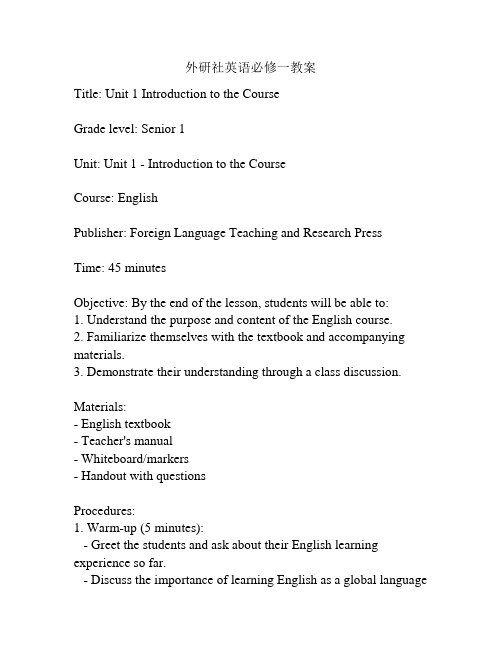
外研社英语必修一教案Title: Unit 1 Introduction to the CourseGrade level: Senior 1Unit: Unit 1 - Introduction to the CourseCourse: EnglishPublisher: Foreign Language Teaching and Research Press Time: 45 minutesObjective: By the end of the lesson, students will be able to:1. Understand the purpose and content of the English course.2. Familiarize themselves with the textbook and accompanying materials.3. Demonstrate their understanding through a class discussion. Materials:- English textbook- Teacher's manual- Whiteboard/markers- Handout with questionsProcedures:1. Warm-up (5 minutes):- Greet the students and ask about their English learning experience so far.- Discuss the importance of learning English as a global languageand the benefits it can bring.2. Introduction (10 minutes):- Present the title of the unit: Introduction to the Course.- Explain that this unit aims to give an overview of the course content and objectives.- Discuss the importance of setting goals and expectations for English learning.3. Textbook Overview (10 minutes):- Distribute the textbooks to the students.- Ask the students to open their textbooks to the first page and follow along.- Introduce the different sections of the textbook, such as the units, vocabulary, grammar, reading, writing, and listening sections. - Highlight the importance of practicing all four language skills: listening, speaking, reading, and writing.4. Class Discussion (15 minutes):- Divide the class into small groups of 3-4 students.- Ask each group to discuss and answer the following questions: - What are your expectations from this English course?- What difficulties do you anticipate in learning English? How do you plan to overcome them?- How can the textbook and other materials help you improve your English skills?- Walk around the class, monitoring the group discussions and providing assistance if needed.- After the discussion, ask each group to share their answers with the whole class.5. Conclusion (5 minutes):- Summarize the main points discussed in the class discussion. - Encourage students to set goals and work hard throughout the course.- Briefly introduce the next lesson or unit.Assessment:- Evaluate students' participation in the class discussion and their ability to articulate their expectations and difficulties in learning English.Extension:- Assign students a reflective task where they write about their language learning experience and goals.- Encourage students to explore additional English resources such as online language learning platforms or English language films and music.Note: This lesson plan is a general outline and can be adjusted to suit the specific needs and abilities of the students. It is important for the teacher to adapt and modify the materials and activities to create an engaging and effective learning experience for the students.。
Extended Project Performance Overview说明书
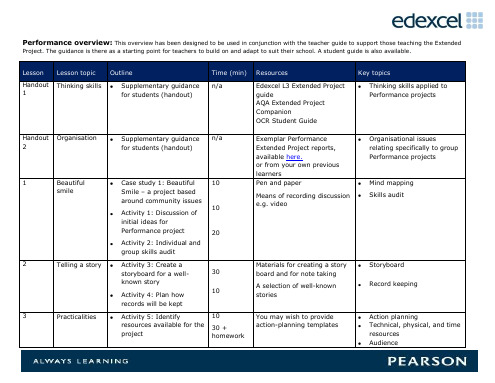
4-7
Hot dog
Lesson
Handout 1
Lesson topic Thinking skills
Outline
Supplementary guidance for students (handout)
Time (min) n/a
Resources
Edexcel L3 Extended Project guide AQA Extended Project Companion OCR Student Guide
Acknowledgments: These free resources were originally published on the Edexcel Level 3 Extended Project Teacher Resource Disc (Heinemann 2009). They have been slightly adapted and updated by the coordinating editors for free dissemination on this website.
Case study 1: Beautiful
10
Smile – a project based
around community issues 10
Activity 1: Discussion of
initial ideas for
医疗器械灭菌过程开发、确认和常规控制要求ISO 11135-2014中英对照本
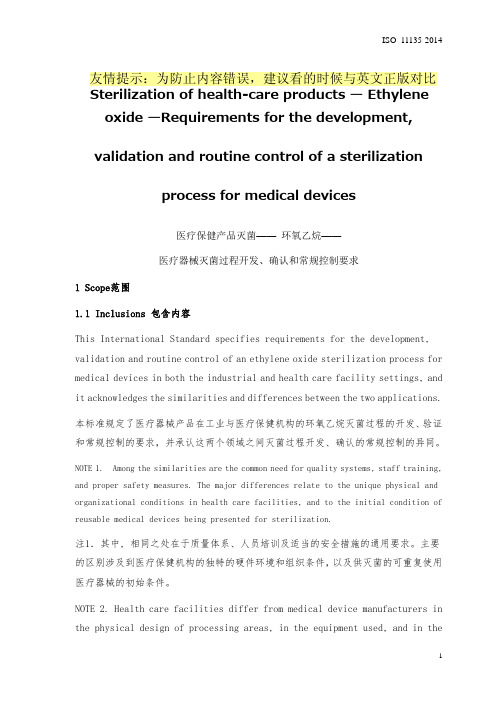
oxide ̶Requirements for the development,validation and routine control of a sterilizationprocess for medical devices医疗保健产品灭菌—— 环氧乙烷——医疗器械灭菌过程开发、确认和常规控制要求1 Scope范围1.1 Inclusions 包含内容This International Standard specifies requirements for the development, validation and routine control of an ethylene oxide sterilization process for medical devices in both the industrial and health care facility settings, and it acknowledges the similarities and differences between the two applications. 本标准规定了医疗器械产品在工业与医疗保健机构的环氧乙烷灭菌过程的开发、验证和常规控制的要求,并承认这两个领域之间灭菌过程开发、确认的常规控制的异同。
NOTE 1. Among the similarities are the common need for quality systems, staff training, and proper safety measures. The major differences relate to the unique physical and organizational conditions in health care facilities, and to the initial condition of reusable medical devices being presented for sterilization.注1.其中, 相同之处在于质量体系、人员培训及适当的安全措施的通用要求。
王蔷英语教学法教程教案
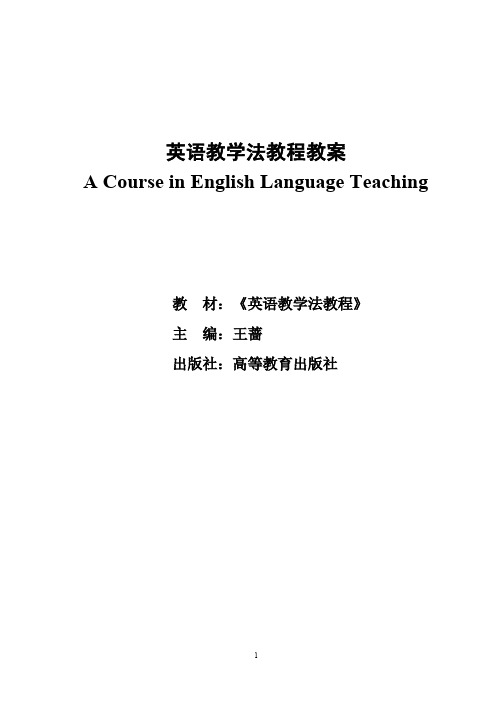
英语教学法教程教案A Course in English Language Teaching教材:《英语教学法教程》主编:王蔷出版社:高等教育出版社绪论外语教学法主要流派Teaching approaches & MethodsApproaches & methods of Language Teaching众说纷纭,现以学习理论作为分类标准,将学派分为认知性的,连接性的和综合性的三大类。
并简介翻译教学法,自然教学法,直接教学法,认知教学法,功能教学法,在这之前首先概述一下拉丁语教学法、。
①拉丁语教学法,指(15-16世纪)为欧洲语言的极盛时期,学校里教授作为外语之拉丁语的直觉模仿法。
它在(15——16世纪)为语法模仿法:16世纪末到17世纪,由于民族语渗入学校,拉丁语教学法主要为词汇模仿法。
先后提出了自觉性原则和直观性原则。
这一时期的两大代表人物①惜提哈(ratch1571-163500))②夸美纽斯教学法Conienius(1592_1670)①德国论点是通过经验与分析去学习一切。
认为只从理论途径得到的记忆才是可靠的。
词汇翻译法,自觉对比法,认真教学法。
二、联结性的教学法学派特点:经验主义的哲学观点;重视外语话语与实物,观念,概念等外部世界与思维的直接联系;侧重口头操练。
自然教学法(绝对排斥本族语的教学法)直接教学法(自然教学法发展起来的)(一种习惯)听说教学法视听教学法功能教学法(又名意念法,交际法或意念——功能—交际法三、综合性的教学法学派,来源于直接法与翻译的综合自觉实践法折衷法(又是极端)分阶段教学法一、语法翻译法(Translation Method)The grammar translation Method(Reading Method ,classical Method ).In China, it is called old method and is probably the most widely known and has been the most widely used of all approaches to language teaching .Although there have been many developments in language teaching, especially in the teaching foreign language ,grammar-translation method in still used today in various forms .And the main drill in translation.The mains features are as the followings.Error! Reference source not found..Classes are taught in the mother tongue,with little active use of the target lauguage.2.Much vocabulary is taught in the form of lists of isofated words.3.Long elaborate explanations of the intricacies of grammar are given.4.Little attention explanations of the intricacies of grammar are given.5.Often the only drills are exercises in translation disconnecfecl sentences from the target language into the mother tongue.6.little or no attention is given to pronunciation.希腊文、拉丁文、通过翻译来学习外语。
RHO-10113 三吨汽车搁浆工具说明书
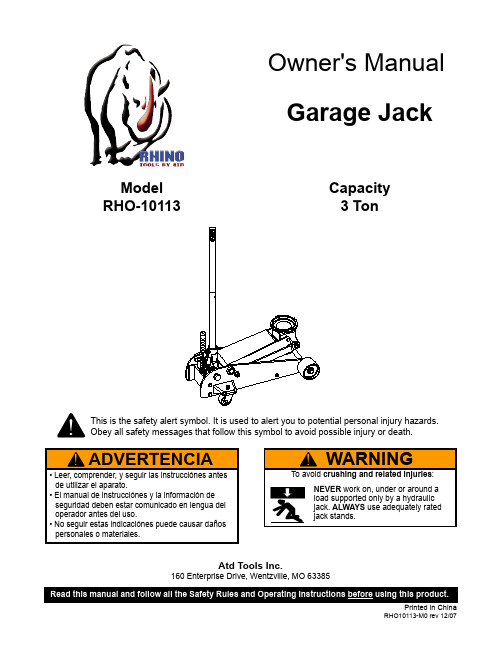
Garage JackModel RHO-10113Owner's Manual Atd Tools Inc.160 Enterprise Drive, Wentzville, MO 63385Capacity3 TonObey all safety messages that follow this symbol to avoid possible injury or death.SAFETY and GENERAL INFORMATIONSave these instructions. For your safety, read, understand, and follow the information provided with and on this jack before using. The owner and operator of this equipment shall have an understanding of this jack and safe operating procedures before attempting to use. The owner and operator shall be aware that use and repair of this product may require special skills and knowledge. Instructions and safety information shall be conveyed in the operator's native language before use of this jack is authorized. If any doubt exists as to the safe and proper use of this jack, remove from service immediately.Inspect before each use. Do not use if broken, bent, cracked or damaged parts are noted. Any jack that appears damaged in any way, or operates abnormally shall be removed from service immediately. If the jack has been or suspected to have been subjected to a shock load (a load dropped suddenly, unexpectedly upon it), immediately discontinue use until jack has been checked by a factory authorized service center (contact distributor or manufacturer for list of authorized service centers). It is recommended that an annual inspection be done by qualified personnel. Labels and Operator's Manuals are available from manufacturer.PRODUCT DESCRIPTIONHydraulic Jack is designed to lift, but not support, one end of a vehicle. Immediately after lifting, loads must be supported by a pair of appropriately rated jack stands.NEVER use hydraulic jack as stand-alone device. After lifting, immediately support the lifted vehicle with PREPARATIONAssemblyAssemble the 2-pc. handle with bolt provided. Then insert the assembled handle into the handle sleeve. Tighten the bolt on handle sleeve to prevent accidental removal of handle while in use.Before Use1. Verify that the product and application are compatible, if in doubt call Atd Tools Technical Service (636) 327-9050.2. Before using this product, read the operator's manual completely and familiarize yourself thoroughly with the product, its components and recognize the hazards associated with its use.3. To familiarize yourself with basic operation of the jack, locate and turn release valve (jack handle):a. Clockwise until firm resistance is felt to further turning. This is the ‘CLOSED ’ release valve position used to raise the saddle.b. Counter-clockwise, but no more than 1/2 turn from the closed position. This is the ‘OPEN ’ release valve position used to lower the saddle.4. With saddle fully lowered, remove the oil filler plug. Pump jack handle 6 to 8 full strokes. This will help release any pressurized air which may be trapped within the reservoir. Check oil level. Proper oil level will vary from just covering the ram cylinder to 3/16” above it as seen from the oil filler hole. Reinstall the oil filler plug.5. Ensure that jack rolls freely. Raise and lower the unloaded saddle throughout the lifting range before putting into service to ensure the pump operates smoothly. Replace worn or damaged parts and assemblies with Atd Tools authorized replacement parts only.Bleeding / Venting Trapped AirWith the release valve in the OPEN position (3b.) and with saddle fully lowered, locate and remove the oil filler plug. Pump 6 to 8 full strokes. This will help release any pressurized air which may be trapped within the reservoir. Reinstall the oil filler plug.SPECIFICATIONSModel Capacity Jack Size (L x W )Min. Height Max. HeightRHO-101133 Ton27 1/2" x 13 3/8"5 1/2"19"OPERATIONLiftingOnly attachments and/or adapters suppliedby the manufacturer shall be used. Lift onlyon area of the vehicle as specified by the vehiclemanufacturer.1. Follow the vehicle manufacturer’s recommendedguidelines for lifting. Engage the emergency brakeand chock each unlifted wheel in both directions toprevent inadvertent vehicle movement.2. Close the release valve by turning the jack handleclockwise until firm resistance is felt.3. Refer to the vehicle manufacturer owner’s manual tolocate approved lifting points on the vehicle. Centerjack saddle under lift point.4. Verify lift point, then pump the jack handle or speedhandle to contact lift point. To lift, pump the jackhandle until load reaches desired height.Note: Do not use speed handle for load lifting.5. Transfer the load immediately to appropriately ratedjack stands.NEVER use hydraulic jack as a standalone device! ALWAYS transfer the lifted loadIMMEDIATELY to a pair of appropriately rated jackstands. Use one pair of jack stands per vehicle.Rated capacity is per pair only! Do not exceed ratedcapacity.LoweringBe sure all tools and personnel are clear beforelowering load. Slowly open the release valve!The more you turn the handle counter-clockwise, thefaster the load will come down. Maintain control of therate of speed at which the load lowers at all times!1. Raise load high enough to clear the jack stands.2. Remove jack stands carefully (always used in pairs).3. Slowly turn the handle counter-clockwise, but nomore than 1/2 full turn. If the load fails to lower:a. Use another jack to raise the vehicle highenough to reinstall jack stands.b. Remove the malfunctioning jack and then thejack stands.c. Use the functioning jack to lower the vehicle.4. After removing jack from under the vehicle, fullylower the saddle to reduce ram exposure to rust andcontamination.Figure 2 - RHO10113 NomenclatureReleaseValve GearMAINTENANCEImportant: Use only good grade hydraulic jack oil. Avoid mixing different types of fluid and NEVER use brake fluid, turbine oil, transmission fluid, motor oil or glycerin. Improper fluid can cause premature failure of the jack and the potential for sudden and immediate loss of load. We recommend Mobil DTE 13M or equivalent.Adding oil1. With saddle fully lowered set jack in its upright, level position. Remove oil filler plug.2. Fill with oil until ~3/16" above the inner cylinder as seen from the oil filler hole. Reinstall the oil filler plug.Changing oilFor best performance and longest life, replace the complete fluid supply at least once per year.1. With saddle fully lowered, remove the oil filler plug.2. Lay the jack on its side and drain the fluid into a suitable container.Note. Dispose of hydraulic fluid in accordance with local regulations.3. Fill with oil until ~3/16" above the inner cylinder as seen from the oil filler hole. Reinstall oil filler plug.LubricationA periodic coating of light lubricating oil to pivot points, axles and hinges will help to prevent rust and assure that wheels, casters and pump assemblies move freely.CleaningPeriodically check the pump piston and ram for signs of rust or corrosion. Clean as needed and wipe with an oily cloth.Note: Never use sandpaper or abrasive material on these surfaces!StorageWhen not in use, store the jack with saddle fully lowered.TROUBLESHOOTINGSymptom Possible Causes Corrective ActionJack will not lift load• Release valve not tightly closed• Load is too heavy • Ensure release valve tightly closed • Consider a higher capacity jackJack will lift, but not maintain pressure •Release valve not tightly closed• Hydraulic unit malfunction•Ensure release valve tightly closed• Discontinue use, contact Atd Toolstechnical serviceJack will not lower after unloading• Reservoir overfilled• Linkages binding• Fluid level low • Drain fluid to proper level• Clean and lubricate moving parts • Ensure proper fluid levelPoor lift performance• Fluid level low•Air trapped in system • Ensure proper fluid level•With ram fully retracted, remove oil filler plug to let pressurized air escape. Reinstall oil filler plugWill not lift to full extension• Fluid level low• Ensure proper fluid levelREPLACEMENT PARTSNot all components of the jack are replacement items, but are illustrated as a convenient reference of location and position in the assembly sequence. When ordering parts, give model number, serial number and description below. Call or write for current pricing: Atd Tools Inc. 160 Enterprise Drive, Wentzville, MO 63385. Tel:(636)327-9050 Fax:(636)327-9044Model RHO-10113Item Description Quantity1 Power Unit 12 Front Wheel Assembly 23 Rear Caster Assembly 24 Saddle 15 Oil Filler Plug 16 Return Spring 17 Handle 18 Release Valve 19 Release Valve Gear 110 Return Spring, Handle Sleeve 211 Bolt & Washer 112 Connecting Bar, Release Valve 113 Speed Handle Assembly 1-- Label(s) 1-- Owner’s Manual 1 Array4Figure 2 - RHO-10113 Replacement Parts90 DAYS LIMITED WARRANTYFor a period of ninety (90) days from date of purchase, Atd Tools Inc. will repair or replace, at its option, without charge, any of its products, which fails due to a defect in material or workmanship under normal usage. This limited warranty is a consumer's exclusive remedy.Performance of any obligation under this warranty may be obtained by returning the warranted product, freight prepaid, to Atd Tools Inc. Warranty Service Department,160 Enterprise Drive, Wentzville, MO 63385.Except where such limitations and exclusions are specifically prohibited by applicable law, (1) THE CONSUMER'S SOLE AND EXCLUSIVE REMEDY SHALL BE THE REPAIR OR REPLACEMENT OF DEFECTIVE PRODUCTS AS DESCRIBED ABOVE. (2) Atd Tools Inc. SHALL NOT BE LIABLE FOR ANY CONSEQUENTIAL OR INCIDENTAL DAMAGE OR LOSS WHATSOEVER. (3) ANY IMPLIED WARRANTIES, INCLUDING WITHOUT LIMITATION THE IMPLIED WARRANTIES OF MERCHANTABILITY AND FITNESS FOR A PARTICULAR PURPOSE, SHALL BE LIMITED TO NINETY DAYS, OTHERWISE THE REPAIR, REPLACEMENT OR REFUND AS PROVIDED UNDER THIS EXPRESS LIMITED WARRANTY IS THE EXCLUSIVE REMEDY OF THE CONSUMER, AND IS PROVIDED IN LIEU OF ALL OTHER WARRANTIES, EXPRESS OR IMPLIED. (4) ANY MODIFICATION, ALTERATION, ABUSE, UNAUTHORIZED SERVICE OR ORNAMENTAL DESIGN VOIDS THIS WARRANTY AND IS NOT COVERED BY THIS WARRANTY.Some states do not allow limitations on how long an implied warranty lasts, so the above limitation may not apply to you. Some states do not allow the exclusion or limitation of incidental or consequential damages, so the above limitation or exclusion may not apply to you. This warranty gives you specific legal rights, and you may also have other rights, which vary from state to state.Atd Tools Inc.160 Enterprise Drive,Wentzville MO 63385636-327-9050。
中国茶道的英文手抄报内容

中国茶道的英文手抄报内容Chinese Tea CultureIntroduction:Chinese tea culture, also known as the art of tea, has a long and rich history. It encompasses various practices, rituals, and beliefs surrounding the cultivation, preparation, and consumption of tea. This handout aims to provide an overview of Chinese tea culture, its historical significance, different types of tea, brewing techniques, and the philosophy that underlies this cherished tradition.1. Historical Significance:China has been renowned for its tea production for thousands of years. The origins of Chinese tea culture can be traced back to ancient times, where tea was initially consumed for medicinal purposes. Over time, tea became highly regarded and gained popularity as a recreational beverage. The Tang Dynasty (618-907) witnessed a flourishing era of tea culture, as tea was embraced by the upper classes and became an integral part of social gatherings and artistic expression.2. Types of Chinese Tea:Chinese tea is classified into several categories based on different criteria such as processing methods, geographical regions, and the appearance of tea leaves. Some of the most popular types of Chinese tea include green tea, black tea, oolong tea, white tea, and Pu-erh tea. Each type possesses its unique flavor profile, health benefits, and brewing techniques.2.1 Green Tea:Green tea is one of the most widely consumed teas in China. It is known for its natural aroma, refreshing taste, and numerous health benefits. Famous variations of green tea include Longjing (Dragon Well), Biluochun (Green Snail Spring), and Bi Luo Chun (Green Spring Snail).2.2 Black Tea:Black tea, also known as red tea in China, undergoes full oxidation during its processing. It has a robust flavor and deep reddish-brown color. Popular types of black tea include Keemun, Yunnan Dianhong, and Lapsang Souchong.2.3 Oolong Tea:Oolong tea falls between green and black tea in terms of oxidation levels. It offers a diverse range of flavors, from floral and fruity to woody and roasted. Notable varieties of oolong tea include Tie Guan Yin (Iron Goddess of Mercy), Da Hong Pao (Big Red Robe), and Phoenix Dancong.2.4 White Tea:White tea is the least processed among all types of tea. It features delicate flavors and a subtle, light aroma. Bai Hao Yinzhen (Silver Needle) and Bai Mu Dan (White Peony) are well-known white tea varieties.2.5 Pu-erh Tea:Pu-erh tea is a fermented tea that undergoes aging, which enhances its flavor and aroma over time. It is often compressed into cakes, bricks, or tuocha shapes. Pu-erh tea can be further classified into raw (sheng) and ripe (shou) types, each offering distinct characteristics.3. Brewing Techniques:The art of brewing tea plays a crucial role in Chinese tea culture. While there are variations in techniques across different tea types, the general process involves selecting high-quality tea leaves, warming the teaware, controlling water temperature, and steeping the tea for an appropriate duration. Skillful brewing allows the flavors and aromas to fully develop, ensuring a delightful tea-drinking experience.4. Tea Utensils and Accessories:The Chinese tea ceremony relies on various utensils and accessories to enhance the aesthetic and sensory aspects of tea appreciation. These include teapots, tea cups, tea trays, tea scoops, tea strainers, and tea tongs. Traditional designs and materials such as clay, porcelain, and bamboo are often used, adding authenticity and charm to the tea-drinking experience.5. The Philosophy of Chinese Tea Culture:Chinese tea culture embodies a profound philosophy that extends beyond the mere act of drinking tea. It reflects principles of harmony, respect, tranquility, and mindfulness. The preparation and consumption of tea encourage individuals to slow down, appreciate the beauty of nature, and savor the present moment. The tranquility associated with tea ceremonies allows for introspection and the fostering of social connections.Conclusion:Chinese tea culture is an integral part of the nation's heritage, representing a harmonious fusion of nature, history, art, and spirituality. It has captivated the hearts of people around the world, serving as a conduit for cultural exchange and mutual appreciation. Exploring the world of Chinese tea opens up a realm of flavors, customs, and traditions that continue to thrive in modern society.(Note: The above article is written in a general format suitable for conveying information about Chinese tea culture. Please adjust the wording and formatting as per your desired format.)。
中国茶道手抄报英语
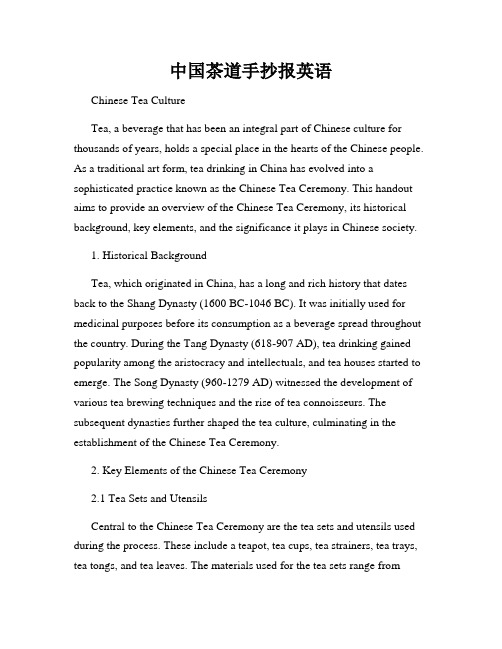
中国茶道手抄报英语Chinese Tea CultureTea, a beverage that has been an integral part of Chinese culture for thousands of years, holds a special place in the hearts of the Chinese people. As a traditional art form, tea drinking in China has evolved into a sophisticated practice known as the Chinese Tea Ceremony. This handout aims to provide an overview of the Chinese Tea Ceremony, its historical background, key elements, and the significance it plays in Chinese society.1. Historical BackgroundTea, which originated in China, has a long and rich history that dates back to the Shang Dynasty (1600 BC-1046 BC). It was initially used for medicinal purposes before its consumption as a beverage spread throughout the country. During the Tang Dynasty (618-907 AD), tea drinking gained popularity among the aristocracy and intellectuals, and tea houses started to emerge. The Song Dynasty (960-1279 AD) witnessed the development of various tea brewing techniques and the rise of tea connoisseurs. The subsequent dynasties further shaped the tea culture, culminating in the establishment of the Chinese Tea Ceremony.2. Key Elements of the Chinese Tea Ceremony2.1 Tea Sets and UtensilsCentral to the Chinese Tea Ceremony are the tea sets and utensils used during the process. These include a teapot, tea cups, tea strainers, tea trays, tea tongs, and tea leaves. The materials used for the tea sets range fromporcelain and clay to glass and bamboo, each providing a unique brewing experience.2.2 Tea SelectionChoosing the right tea is crucial in the Chinese Tea Ceremony. There are various types of Chinese tea, including green tea, black tea, oolong tea, white tea, and pu-erh tea. Each type has its specific flavor profiles and brewing methods, with tea connoisseurs emphasizing the importance of selecting high-quality tea leaves to elevate the tea-drinking experience.2.3 Brewing ProcessThe brewing process is a meticulous and deliberate act in the Chinese Tea Ceremony. It involves heating the tea pot, rinsing the tea leaves with hot water, and subsequently adding water at a specific temperature to extract the flavors and aromas of the tea leaves. The tea is then poured into small cups and served to the guests.2.4 Etiquette and RitualsThe Chinese Tea Ceremony is not merely about brewing and drinking tea but also encompasses a set of etiquette and rituals. These include serving tea to the guests using specific hand movements, bowing to show respect, and engaging in thoughtful conversations about tea. The ceremony promotes harmony, tranquility, and appreciation for the art of tea.3. Significance of the Chinese Tea Ceremony3.1 Cultural PreservationThe Chinese Tea Ceremony serves as a powerful means of preserving China's cultural heritage. It has been passed down through generations, ensuring that the art of tea remains alive and relevant in a rapidly changing world. Participating in the Chinese Tea Ceremony allows individuals to connect with their roots and appreciate the essence of Chinese culture.3.2 Social BondingTea has always been regarded as a symbol of hospitality and friendship in Chinese society. The act of serving and receiving tea promotes social bonding and fosters relationships. The Chinese Tea Ceremony provides a platform for individuals to gather, engage in meaningful conversations, and forge connections over a shared cup of tea.3.3 Health BenefitsAside from its cultural and social significance, the consumption of tea also offers numerous health benefits. Chinese tea is known for its antioxidant properties, promoting digestion, boosting the immune system, and reducing the risk of heart disease. Regular participation in the Chinese Tea Ceremony encourages a healthier lifestyle and cultivates mindfulness.ConclusionIn conclusion, the Chinese Tea Ceremony embodies the essence of Chinese tea culture, featuring a combination of history, aesthetics, and mindfulness. A celebration of tradition and an expression of art, it continues to enchant people across the globe. By understanding and embracing the Chinese Tea Ceremony, individuals can embark on a journey of self-discovery while appreciating one of China's most cherished cultural treasures.。
- 1、下载文档前请自行甄别文档内容的完整性,平台不提供额外的编辑、内容补充、找答案等附加服务。
- 2、"仅部分预览"的文档,不可在线预览部分如存在完整性等问题,可反馈申请退款(可完整预览的文档不适用该条件!)。
- 3、如文档侵犯您的权益,请联系客服反馈,我们会尽快为您处理(人工客服工作时间:9:00-18:30)。
9
3GPP Timing Options
• The 3GPP System has Two Timing Modes:
ü Asynchronous Operation - Original Mode ü GPS Synchronized - Added after Harmonization
• Asynchronous Mode:
• Improved Performance and Capacity: ØAbout 2X Capacity of TIA/EIA-95-B ØHandles a Wide Range of Data Rates:
ü Voice and Low Speed Data while Driving ü Up to 384 kbps Packet or Circuit Data while Moving ü Up to 2 Mbps Data Rates for Fixed Installations
ü Chip Rate - 4.096 vs. 3.6864 ü Pilot Method - Code vs. Embedded ü Synchronization - GPS vs. None
• Known as “ G3G”Global 3G • 3GPP Adopted Proposal on July 7, 1999 • 3GPP2 Adopted Proposal on July 14,1999
• Europe:
ü ETSI Developed a WCDMA System
• These Two Systems Were Similar:
ü 4.096 Mcps, Direct Spreading, Unsynchronized
• ARIB and ETSI Merged into 3GPP (“ Third
TIA T1
ETSI
ARIB
Telecommunications China Technology Wireless Association Telecommunication Standards
CWTelecommunication
Technology Committee
3G 2G+
HSCSD,GPRS EDGE
IMT-2000
Wideband CDMA, WTDMA
SERVICES
1995 2000
2G
DIGITAL
GSM, NADC 1992 CDMA,PDC
1985 GLOBAL
LOCAL
INTERNATIONAL NATIONAL
COVERAGE
2
Standards Bodies
ü Indoor Office ü Wireless Local Loop
4
IMT-2000 Worldwide Standard
3GPP WCDMA
IS-2000 3GPP TDD (cdma2000)
UWC-136
DECT
Adopted in November 1999
5
TIA/EIA-95B CDMA Derivative
United Nations
ITU
United States Europe Japan China Korea
Telecommunications Association of European Industry Radio Telecommunications Association Industries & Standards Businesses Institute
• GPS Synchronized Mode:
ü Simpler, Faster Searching to Ease Soft Handoffs ü Requires Base Station to Receive GPS Satellite Signals
10
Standards Consolidation
• Only 3-G Upgrade Proposal that Allows a Smooth Upgrade from 2-G System (TIA/EIA-95A/B) • Standard Approved on July 12, 1999
6
Benefits of IS-2000 CDMA
• Standard will be IS-2000 • System Name is cdma2000 • Originally Included Three Modes:
ü Improved 1.2288 Mcps CDMA Mode (SR1) ü Three 1.2288 Mcps Carrier Mode to Allow Overlays with IS-95B (SR3 MC) ü 3.6864 Mcps Direct Spread Mode (SR3 DS)
• G3G Harmonized Direct Spread:
ü 3.84 Mcps Common Rate ü Code Based Global Pilot ü GPS Synchronized or Unsynchronized Modes
• 3GPP TDD Mode • Support both GSM and IS-41 Network Architectures
United States
Europe
ETSI
China
CWTS
Japan
TTC ARIB
Korea
TTA
T1
TIA
3GPP
Worldwide WCDMA
3GPP2
Worldwide cdma2000
11
Harmonization Effort
• A Group Of Equipment Manufacturers and Operators (OHG) Proposed Harmonization: ØBiggest Issues:
From: China Preparing IMT-2000 and 3G Mobile Network Sep.26-28, Beijing
15
12
G3G Harmonization Proposal
• cdma2000 SR1 & SR3 Multi-Carrier:
ü Retain Backwards Compatible 1.2288 Mcps Rate ü Code Based Global Pilot ü GPS Synchronized
Generation Partnership Project” )
8
Benefits of 3GPP WCDMA
• Higher Capacity - about 2X IS-95, 7X GSM • Ability to Send up to 384 kbps High Speed Data while Moving (Internet, video, multimedia, etc.) • Up to 2 Mbps Throughput for Fixed Applications • 5 MHz Bandwidth is more Immune to Fading • No Accurate Base Station Synchronization Needed • Support for Hand-off To and From GSM
13
What is G3G?
cdma2000 W-CDMA
IS-41
MAP
14
Appendix
TD-SCDMA
• TD-SCDMA RTT is the most attractive technology in IMT2000 CDMA TDD mode • The main features in TD-SCDMA is come from the technologies such as Smart Antenna, Joint detection, Up-link Synchronization, etc. which is developed by international coop (CATT and Siemens) • Based on Software Radio, Node B and UE is designed and implemented • The best way from GSM to 3G by using TD-SCDMA is Proposed.
ü Eliminates need for GPS Satellite Receivers ü Allows Operation in Tunnels, Buildings, and Subways Where Satellite Reception is Difficult ü Requires Greater Search Time, More Difficult Handoffs
• Meets All IMT-2000 Requirements • Easy Upgrade for Service Providers Who Currently Operate TIA/EIA-95 Systems
7
New WCDMA Proposals
• Japan:
ü NTT DoCoMo Developed a Proprietary System Called WCDMA ü ARIB Standards Body Developed an Open Architecture Version Called ARIB WCDMA
3
IMT-2000 Requirements
• To Meet the High Speed Data Requirements, a 3-G System must Support: Ø144 kbps Data for High Speed Vehicular Environment Ø384 kbps Data for Pedestrian or Low Speed Vehicular Environment Ø2 Mbps Data for Stationary Environment
